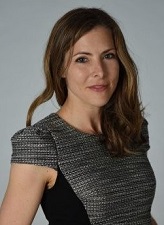
Fall 2017
To Industry and Back Again: Stories from the Road Less Traveled​

Kirstin Aschbacher, PhD
SBM’s Behavioral Informatics & Technology Special Interest Group (BIT SIG) recently interviewed Kirstin Aschbacher, PhD, Associate Professor & Data Scientist at University of California San Francisco, Department of Cardiology to discuss career transitions and her experience between academia and industry jobs.
BIT SIG: Can you tell us how you made your career transition from Academia to health tech industry and back into academia?
Dr. Aschbacher: I find it is a little easier to make big decisions (like changing jobs) if I can get a sense of how it might feel first. I started by just sending my resume out to a couple industry jobs to see if I would even get an interview. After a couple interviews, I started to see where some of my skill deficits were, which ultimately led me to finding the Insight Data Science fellowship. At the time, I had a K23 Career Development Award, which funded me as an Assistant Professor on a 100% soft money track in the Medical School at University of California San Francisco (UCSF). I knew I was going to need multiple RO1 grants to sustain my salary once the K23 ended. I felt like it was a huge jump to make. I was a mother raising a toddler, and I just did not want to give up the opportunity to spend most evenings and weekends with my son while he was so little. The Insight Data Fellowship led to a job offer as a Data Scientist working on a behavior change App at a wearables start-up, Jawbone. Ironically, this experience later allowed me to return to UCSF in the Division of Cardiology in a supported position as an Associate Professor, where I work on a “start-up” Digital Research App, which is built around a cohort of roughly 125,000 individuals in the Health eHeart cohort.
BIT SIG: Did you get a chance to work on apps and software during your doctoral degree or post-doc?
Dr. Aschbacher: I started programing games when I was 10 years old, though I stopped once I hit high school. After college, I started programming again by taking classes in Java. During graduate school, I taught statistics, and in my dissertation, I wrote a program to automate a large volume of data from flow cytometry experiments. In my post-doc, I taught myself to program in Matlab in order to build control systems models to tackle questions that cannot be modeled by more commonly used statistics.
BIT SIG: How was your experience interviewing for the industry jobs?
Dr. Aschbacher: My pathway into industry was definitely via the technical skills of Data Science; however, companies thought it was a “bonus” that I also had behavior change and research design training. I found the process of interviewing for industry data science jobs to be quite difficult (white board coding interviews are no joke). However, I now feel like I have a lot more job security and options.
BIT SIG: What are the pros and cons of Academia and Industry in your opinion?
Dr. Aschbacher: In academia, I have enjoyed a more flexible schedule, and I have had greater autonomy in choosing what I work on. In industry, I learned how to implement an idea quickly, at scale, as part of a team. I gained a lot of technical skill quickly because I was surrounded by very talented people. In some ways, I felt freer to innovate, because I didn’t have to cite a huge body of evidence and raise funding to test an idea. Within just a couple of weeks, I could receive feedback from real users on the interventions that I helped develop and implement. That was very satisfying! However, sometimes in industry products are developed primarily based on design, business, and engineering needs, and science takes a back seat.
BIT SIG: How can people change CVs to industry-suitable resumes?
Dr. Aschbacher: Ideally your resume should be 1-2 pages. Under each experience, write one sentence or a series of short bullets that describe your research as “projects” and highlight the technical tools you used. I summarized my publications and grant funding literally in one sentence.
BIT SIG: What was the most challenging part of the career transition?
Dr. Aschbacher: Change is scary. I had to continually remind myself that I was committing to a way of being, not a goal. As an academic, I used to feel like my career was defined by external badges of honor – publications, awards, grants, etc. In my new path, I decided my career was going to be defined by my values. I don’t care whether the job is in industry or academia, but I want a healthy balance in my own life and I want to build interventions that reach people.